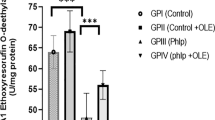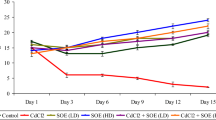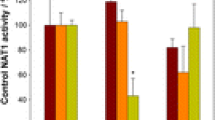Abstract
Diet contains several substances capable of inhibiting chemical carcinogenesis. It is known that such inhibitors may either act directly by scavenging the reactive substances or indirectly by promoting mechanisms which enhance detoxification. Turmeric which contains curcumin both in vitro and in vivo is an active antimutagen. Studies were therefore conducted to evaluate the effects of turmeric on xenobiotic metabolising enzymes in hepatic tissue of rats fed turmeric ranging from 0.5–10% in the diet. Enzymes such as aryl hydrocarbon hydroxylase, UDP glucuronyl transferase and glutathione-S-transferase were assayed after four weeks of turmeric fed diets. No significant differences were seen in the activating enzyme AHH. However, UDPGT was significantly elevated in rats fed 10% turmeric while GSHT registered a significant increase in 5 and 10% turmeric fed diet as compared to controls and 0.5–1.0% turmeric fed animals. The results suggest that turmeric may increase detoxification systems in addition to its anti-oxidant properties. Curcumin perhaps is the active principle in turmeric. Turmeric used widely as a spice would probably mitigate the effects of several dietary carcinogens.
Similar content being viewed by others
References
Wattenberg LW (1983) Inhibition of neoplasia by minor dietary constitutents. Cancer Res 43: 2448S-2453S.
Polasa K, Sesikaran B, Prasanna Krishna T, Krishnaswamy K (1991) Antimutagenicity of turmeric (Curcuma longa). Fd Chem Toxicol 29: 699–706.
Chandra D, Gupta SS (1972) Antiinflammatory and antiarthritic activity of volatile oil of Curcuma longa (Haldi-turmeric). Indian J Med Res 60: 138–142.
Govindarajan VS (1980) Turmeric chemistry, technology and quality. CRC Reviews. Food Sci Nutr 12: 199–301.
Subba Rao D, Chandrasekhara N, Satyanarayana MN, Srinivasan M (1970) Effect of curcumin on serum and liver cholesterol levels in the rat. J Nutr 100: 1307–1315.
Ames BN (1983) Dietary carcinogens and anticarcinogens. Science 221: 1256–1263.
Cantrell E, Abre M, Busbee (1983) A simple assay of aryl hydrocarbon hydroxylase in cultured human lymphocytes. Biochem Biophys Res Commun 70: 474–479.
Woodcock BG, Wood GG (1971) A simple assay of aryl hydrocarbon hydroxylase in cultured human lymphocytes. Biochem Biophys Res Commun 70: 474–479.
Habig WH, Pabst MJ, Jakoby WN (1974) Glutathione-S-transferase: The first enzyme step in Mercapturic acid formation J Biol Chem 249: 7130–7139.
Lowry OH, Rosebrough NJ, Farr AL, Randall RJ (1951) Protein measurement with the folin phenol reagent. J Biol Chem 193: 265–276.
Snedecor GW, Cochran WA (1967) Statistical methods. Ames: Iowa State University Press, pp 258–271.
National Research Council (1982) Diet, Nutrition and Cancer. Washington DC: National Academy Press.
Sparnins VL, Venegas PL, Wattenberg LW (1982) Glutathione S transferase activity: Enhancement by compounds inhibiting chemical carcinogenesis and by dietary constituents. J Natl Cancer Res 68: 493–496.
Wattenberg LW (1982). Inhibition of chemical carcinogens by minor dietary components. In: Arnott MS, Van Eys J, Wang YM (eds), Molecular interrelations of nutrition and cancer. New York: Raven Press, pp 43–56.
Wattenberg LW (1977) Inhibition of carcinogenic effects of polycyclic hydrocarbon by benzyl isothiocyanate and related compounds. J Natl Cancer Inst 58: 195–398.
Ramesh RP, Krishnaswamy K (1991) Effect of common vegetables and species on xenobiotic metabolising enzymes and in vivo carcinogen-DNA binding. Plant Foods Hum Nutr. (communicated).
Lam, LKT, Hasegawa S (1989) Inhibition of benzo(a)pyrene induced forestomach neoplasia in mice by citurs limonoids. Nutr and Cancer 12: 43–47.
Boyd JN, Babish JA, Stoewsand FS (1982) Modification of beet and cabbage diets of aflatoxin B1 induced rat plasma and alpha foetoprotein elevation tumorigenesis and mutagenesis in urine. Fd Chem Toxicol 20: 47–52.
Stoewsand GS, Babish JG, Wimberly HC (1978) Inhibition of hepatic toxicities from polybrominated biphenyls and afla-toxin B1 in rats fed cauliflower. J Environ Pathol Toxicol 2: 399–406.
Wattenberg LW (1980) Inhibitors of chemical carcinogenesis. J Environ Pathol Toxicol 3 940: 35–52.
Philips DH (1983) Fifty years of benzo(a)pyrene. Nature 58: 413–417.
Lam LKT, Wattenberg LW (1977) Effect of butylated hydroxyanisole on the metabolism of benzo(a) pyrene by mouse liver microsomes. J Natl Cancer Inst 58: 413–417.
Speier JC, Wattenberg LW (1975) Alterations in microsomal metabolism of benzo(a)pyrene in mice fed butylated hydroxyanisole. J Natl Cancer Inst 55: 469–472.
Nagabhushan M, Bhide SV (1987) Antimutagenicity and anticarcinogenicity of turmeric (Curcuma longa). J Nutr Growth and Cancer 4: 83–89.
Kuttan RP, Bhanumurthy P, Nirmala K, George MC (1985) Potential anticancer activity of turmeric (Curcuma longa). Cancer Lett 29: 197–202.
Huang MT, Smart RC, Wong CQ, Conney AH (1988) Inhibitory effect of curcumin, chlorogenic acid, caffeic acid and ferulic on tumor promotion in mouse skin by 1.2.0-Tetra decanoylphorbol-13-acetate. Cancer Res 48: 5941–5946.
Torigoe T, Arisawa M, Itoh S, Fujiu M, Maruyama HB (1983) Antimutagenic chalcones: Antagonizing the mutagenicity of benzo(a)pyrene on Salmonella typhimurium. Biochem Biophys Res Commun 112: 833–842.
National Cancer Registry (1986) Annual Report. New Delhi: ICMR Publications.
Author information
Authors and Affiliations
Rights and permissions
About this article
Cite this article
Goud, V.K., Polasa, K. & Krishnaswamy, K. Effect of turmeric on xenobiotic metabolising enzymes. Plant Food Hum Nutr 44, 87–92 (1993). https://doi.org/10.1007/BF01088486
Received:
Accepted:
Issue Date:
DOI: https://doi.org/10.1007/BF01088486




